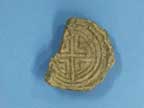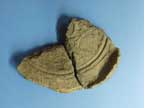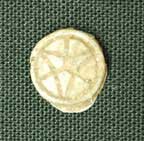 Bulletin 7, 2001-2
Bulletin 7, 2001-2
Publications in preparation, 2001-2002
The Field Report for Sector 1 was written by Madeleine Hummler in the winter of 2002 and will be updated and completed in 2003 on the completion of the excavation of S1.
Volume 1 of the Research Report, on St Colman’s Church, its, burial ground and sculpture, was in preparation by Martin Carver in 2001/2. The sequences of church-buildings and burials composed by Annette Roe have been endorsed and samples from a stratified series of burials have been sent for radiocarbon dating.
Aninterim report on the Research at Portmahomack was completed by Martin Carver and is to appear in Medieval Archaeology in 2004- “Columba’s Port: an early medieval monastery in Pictland”.
Sculpture on the Tarbat peninsula. Interim studies of the stone monuments of Nigg, Shandwick and Hilton of Cadboll and the figurative elements of the Portmahomack assemblage were presented by Kellie Meyer at Kalamazoo and Edinburgh. A paper on the iconography of the Tarbat group is to be published in Able Minds and Practised hands, a volume on early historic sculpture in Scotland edited by Sally Foster. Kellie Meyer’s doctoral thesis on the Tarbat group of sculpture at the University of York is scheduled for completion in 2003.
Sculpture in Action: contexts for stone carving on the Tarbat Peninsula, was the subject of a paper prepared by Martin Carver to be published in Able Minds and Practised hands, a volume on early historic sculpture in Scotland edited by Sally Foster.
Analysis of craft-working debris by Cecily Spall continues, with investigations of leather and glass working and classification of moulds and crucibles (see Clay moulds and crucibles and Evidence for Craft-working from Sector 1, 2001 - 2002 ).
The recording of the Portmahomack churchyard memorials was completed by Gary Nayar in 2002 and is being entered into a data-base to be used for both research and display. A new churchyard recording project began in early 2003, under the direction of Kate Collard (Manager, Tarbat Discovery Centre), which will cover Nigg and Edderton.
Clay moulds and crucibles
Andrew Heald, National Museums of Scotland
The metal-working debris recovered at Portmahomack is being examined by typological and physical analysis (XRF). The research will not only throw light on the technique and products adopted, but place this late Iron Age industry in the broader context of the development of metallurgy in Scotland and contribute to our understanding of the role of the smith in a changing society between c700BC and AD 800 (Heald 2003). Initial investigations have defined the following types of mould and crucible which were employed at Tarbat.
More than 50 crucible fragments have been identified, and a proportion of these were sufficiently complete to find a match with forms known from the period (eg Lane and Campbell 2000, 134-147) (see Finds Section). Metal residues inside and outside the crucible sherds were examined non-destructively by X-ray fluorescence (XRF). Identified types include open-topped triangular crucibles used throughout the first millennia BC/AD, XRF analysis shows that these were associated with the working of silver and copper-alloys. Unlidded bag-shape crucibles (Lane and Campbell’s Type D (2000, 141) were also present in the assemblage. These are made by wrapping a thin disc of clay around a finger or thumb and pinching the overlap into a handle. Analysis of this type from Dunadd (Argyll) suggest that they were used for precious metals, probably mainly gold (Lane and Campbell 2000, 206), although they may also be used for copper-alloy (Duncan 1982, 56). Portmahomack examples examined so far show traces of both precious metals and copper.
Small Flat-bottomed vessels sometimes known as “dog-bowls” were also included in the assemblage. They may be intended for working either metal or glass. Similar vessels are known from Brough of Birsay, Orkney (Curle 1982, 42, illus 25, nos 410, 411), Clatchard Craig, Fife (Close-Brooks 1986, 165, illus 27, nos 107) and Dunadd, Argyll (Lane and Campbell 2000, 136, illus. 4.41, no 1632). Analysis of examples from Dunadd produced traces of metals (Lane and Campbell 2000, 206). Some Portmahomack examples had a distinctive yellow residue with a high lead and tin component. Lead-rich yellow residues adhering to flat-bottomed vessels from Wijnaldum, Holland were interpreted as referring to glass-working (Henderson 1999, 293-4). Like the Portmahomack examples, that from Wijnaldum was found amongst waste from metal-working, suggesting these crafts took place together (Sablerolles 1999, 264). The assemblage includes many fragments of two-piece casting moulds. Near-complete examples suggest the production of pins, rings, ingots and glass studs, and at least one cruciform object.
This preliminary review shows that the Portmahomack material can be parallelled on many late Iron Age sites in Scotland, both secular like Dunadd (Christison and Anderson 1905, 311-4; Craw 1930, 120-3; Lane and Campbell 2000, 106-49) and Brough of Birsay (Curle 1982), or monastic such as Iona (McCormick 1992; Graham-Campbell 1981; Barber 1981, 349-50). Future analyses will concentrate on defining the form and residues of the whole assemblage and matching them to the activities and lay-out of the work-shop area.
Evidence for Craft-working
from Sector 1, 2001 - 2002
Cecily Spall, Field Archaeology Specialists
The 2001 and 2002 season added significantly to the growing assemblage of early medieval glass- and metal-working debris which had hitherto come principally from excavations in Sector 2. Now from Sector 1 a total of 86 crucible fragments and 236 clay mould fragments has been recovered, by hand-collection, from coarse and fine-mesh sieving and from flotation residues. Copper-alloy and glass droplets, iron objects and heating trays complement these finds.
The form of crucibles would appear to reflect those in use in Sector 2, ie, bag-shaped and triangular. The range of moulds include some that are ornate and can be referred to glass-working. One example is round and slightly hemispherical, measuring 31mm in diameter; it bears an interlace cross decoration and resembles the ornate mould recovered from the same area in 2000 (see Bull. 6). Another is fragmentary but clearly part of a much larger mould; it bears a faint peltaic design measuring 74mm in diameter with a central decorated area of 52mm in diameter).


Click to view larger images of the cross mould and peltaic mould.
The cast object might may have been a decorative escutcheon possibly for a book cover. These one-piece moulds were designed for receiving glass rather than molten metal, as indicated the glass stud (or escutcheon) found in its mould at Lagore Crannog (Hencken 1950, Fig. 62, 1302a,b; Youngs 1989, 205).
A small opaque white glass stud with geometric decoration was also recovered. The decoration mimics that of the ornate blue glass stud found in 2000 (see Finds Section) although due to the object’s small size (6mm in diameter) the design is more simple. The Y-division radiates from the centre of the mould that is also divided by three curved lines, creating cells. Like the blue glass stud, the object was clearly intended to be fixed to a larger object since it has a flange around its circumference presumably to receive a metal collar. This object does not seem to have been discarded as a failure, instead its minute size might explain its loss. Two large trails or dribbles of glass, one opaque yellow, the other a dark opaque yellowish-green, that may derive from monochrome glass rods, were also recovered. Monochrome glass rods have been found on many Irish early Christian sites, for example, sites in Armagh, Moynagh Lough, Garranes and Dunmisk (Henderson 2000, 147) where they have been associated with bead making.

Click to view larger image of white glass stud from Sector 1.
Elsewhere in Sector 1, F34, a small scoop, yielded some significant residues notably in the form of two copper-alloy droplets and a blue glass droplet. This is the clearest evidence yet for in situ craft-working in the Sector since such micro-residues would not be expected to travel far from the site of manufacture. Earlier seasons recovered a raw blue glass lump and opaque yellow enamel on heating tray fragments. The evidence from Tarbat so far indicates that dark and light blue, opaque yellow and opaque white glass was acquired for working at the site.
References
Barber J 1981 `Excavations on Iona 1979' PSAS 111: 282-380
Christison D and Anderson J 1905 `Report on the Society’s excavations of forts on the Poltalloch Estate, Argyll in 194-5' PSAS 39: 259-322
Close-Brooks J 1986 `Excavations at Clatchard Craig, Fife’ PSAS 116: 117-184
Craw J H 1930 `Excavations at Dunadd and at other sites on the Poltalloch Estates Argyll’ PSAS 64: 111-146.
Curle C L 1982 Pictish and Norse Finds from the Brough of Birsay 1934-74 (SAS Mono 1)
Duncan H 1982 Aspects of the Early Historic Period in South West Scotland (unpub. MPhil thesis, University of Glasgow)
Graham-Campbell J 1981 'The bell and the mould’ in Reece R (ed) Excavations in Iona 1964-1974 (London: Institute of Archaeology)
Heald, Andrew 2003 Non-ferrous metalworking in Iron Age Scotland, c700 BC to AD 800 (PhD Dissertation, University of Edinburgh)
Hencken, H.O.N. 1950. ‘Lagore Crannog: an Irish Royal residence of the 7th to 10th centuries A.D.’ Proceedings of the Royal Irish Academy 53C:1-247 (Dublin)
Henderson J 1999 `Scientific analysis of the glass and the glass-bearing artefacts: technique, raw materials used, and archaeological interpretation’ in Besteman JC, Bos JM, Gerrets DA, Heidinga HA and Koning J de (eds) The Excavations at Wijnaldum. Reports on Frisia in Roman and Medieval Times. Vol I (Rotterdam/Brookfield): 287-297.
Henderson J. 2000. ‘The production, technology of Irish early Christian glass with special reference to beads and enamels’ in Price, J. (Ed. ) Glass in Britain and Ireland AD350 - 1100 (British Museum: London): 143-160
Lane A and Campbell E 2000 Dunadd: an early Dalriadic capital (Oxford)
McCormick F 1992 'Early Christian metalworking on Iona: excavations under the 'infirmary' in 1990' PSAS 122: 207-214.
Sablerolles Y 1999 `Beads of glass, faience, amber baked clay and metal, including production waste from glass amber bead-making’ in Besteman JC, Bos JM, Gerrets DA, Heidinga HA and Koning J de (eds) The Excavations at Wijnaldum. Reports on Frisia in Roman and Medieval Times. Vol I (Rotterdam/Brookfield):235-285.
Youngs, S. 1989. The Work of Angels, Masterpieces of Celtic metalwork, 6th to 9th centuries AD, (British Museum: London)
NEXT: Publications
BACK: Excavations
Last updated 10 October, 2003.
Contact the Tarbat Discovery Programme


